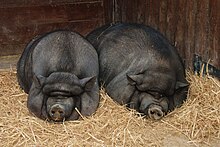Pot-bellied pig
A pot-bellied pig (also Vietnamese pot- bellied pig ) is a breed of domestic pig ( Sus scrofa f. Domestica ) bred in Southeast Asia from the Eurasian wild boar ( Sus scrofa ) . The thesis that the Asian domestic pig breeds developed from a subspecies of the wild boar, the binding pig ( Sus scrofa vittatus ), is controversial. There are 14 known breeds of pot-bellied pigs. The pot-bellied pig is counted among the mini- pigs .
They are mostly gray-black or gray-black piebald animals with thick and wrinkled skin. The head is short, dented and has small erect ears. Compared to body height ( boar shoulder height : 50 cm; sow : 40 cm, boar weight: 60–70 kg, sow: 50–60 kg), the animals are quite long. It is named after the fact that the belly of the animals almost drags on the ground as a result of their small size.
The breed was first secured in 1958 by Animal Inspector W. Fischer imported to Europe in the Berlin-Friedrichsfelde Zoo . Information that pot-bellied pigs were already being kept when the Budapest Zoo opened in 1866 is questionable. In the zoo guide of that time, the name Foldenschwein Japan is said to have been used.
As a result of their ability to establish social relationships and their relatively small body size, representatives of the breed have found worldwide distribution as pets within hobby breeding in recent years .
The Vietnamese pot-bellied pig served with the Minnesota Minipig as the starting breed for the breeding of the Göttingen mini-pig .
References
- ^ Hans Hinrich Sambraus : Atlas of the farm animal races , Ulmer, Stuttgart 1996, ISBN 3-8001-7348-4 .

